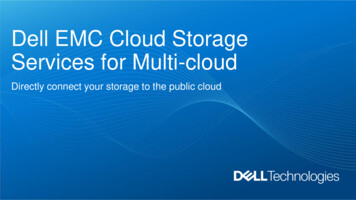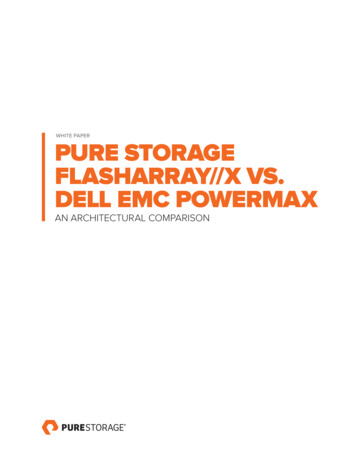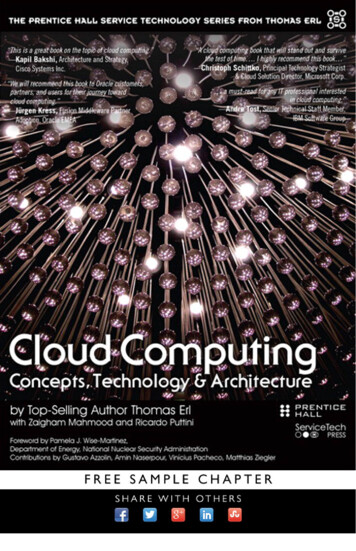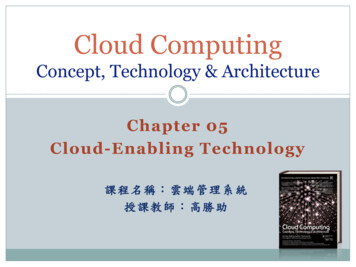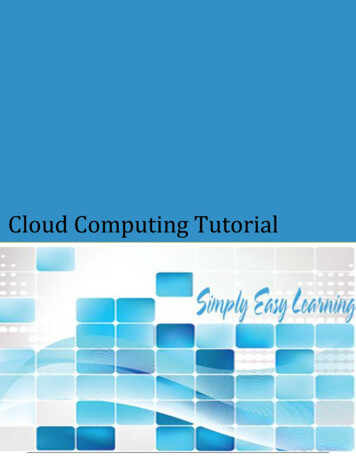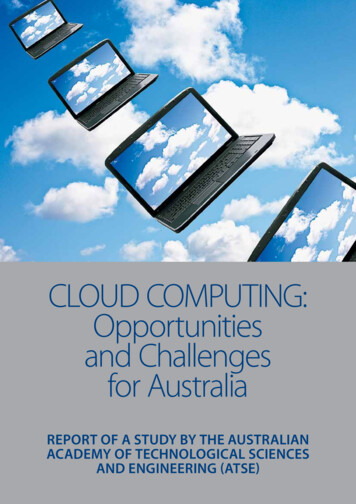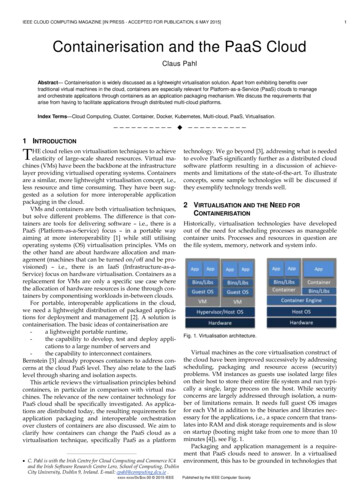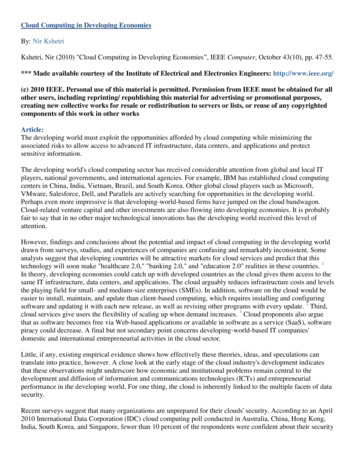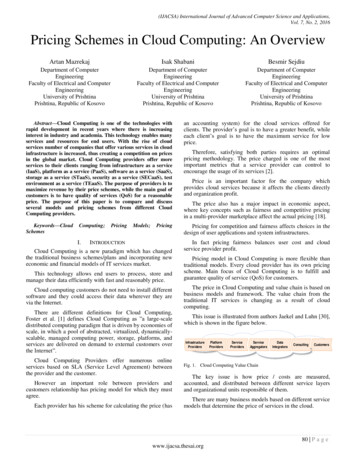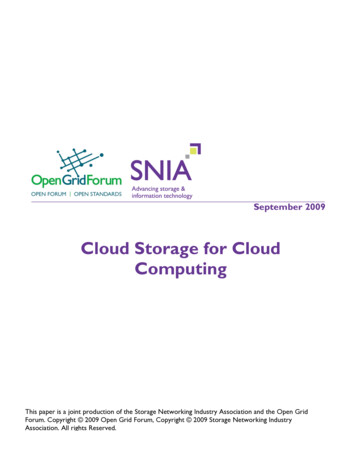
Transcription
September 2009Cloud Storage for CloudComputingThis paper is a joint production of the Storage Networking Industry Association and the Open GridForum. Copyright 2009 Open Grid Forum, Copyright 2009 Storage Networking IndustryAssociation. All rights Reserved.
Cloud Storage for Cloud ComputingTable of ContentsIntroduction.4Cloud Computing Overview .4From Server Consolidation to Cloud Computing. 4The role of server virtualization software . 4How is all this managed?. 4Standardizing Cloud Computing Interfaces.5Introducing OCCI . 5The OCCI Reference Architecture . 5Cloud Storage Overview.7Some of the Use Cases. 7Web facing applications . 7Storage for Cloud Computing. 8What makes Cloud Storage different? . 8Introducing CDMI .8Using CDMI and OCCI for a Cloud Computing Infrastructure.9How it works . 11Standards Coordination . 11About the SNIA . 11OGFiiOPEN GRID FORUM andSTORAGE NETWORKING INDUSTRY ASSOCIATION
Cloud Storage for Cloud ComputingList of FiguresFigure 1: The OCCI API.5Figure 2: Alignment of OCCI URI to IaaS Resources .6Figure 3: The OCCI Lifecycle Model.7Figure 4: The Cloud Storage Reference Model .9Figure 5: CDMI and OCCI in an integrated cloud computing environment . 10OGFiiiOPEN GRID FORUM andSTORAGE NETWORKING INDUSTRY ASSOCIATION
Cloud Storage for Cloud ComputingIntroductionThe Cloud has become a new vehicle for delivering resources such as computing and storage tocustomers on demand. Rather than being a new technology in itself, the cloud is a new business modelwrapped around new technologies such as server virtualization that take advantage of economies ofscale and multi-tenancy to reduce the cost of using information technology resources.This paper discusses the business drivers in the Cloud delivery mechanism and business model, whatthe requirements are in this space, and how standard interfaces, coordinated between differentorganizations can meet the emerging needs for interoperability and portability of data between clouds.Cloud Computing OverviewRecent interest in Cloud Computing has been driven by new offerings of computing resources that areattractive due to per-use pricing and elastic scalability, providing a significant advantage over the typicalacquisition and deployment of equipment that was previously required. The effect has been a shift tooutsourcing of not only equipment setup, but also the ongoing IT administration of the resources aswell.From Server Consolidation to Cloud ComputingThe needed changes to applications, in order to take advantage of this model, are the same as thoserequired for server consolidation – which had already been taking place for several years prior to theadvent of the Cloud. The increased resource utilization and reduction in power and coolingrequirements achieved by server consolidation are now being expanded into the cloud.The role of server virtualization softwareThe new technology underlying this is the system virtual machine that allows multiple instances ofan operating system and associated applications to run on single physical machine. Delivering this overthe network, on demand, is termed Infrastructure as a Service (IaaS). The IaaS offerings on themarket today allow quick provisioning and deployment of applications and their underlying operatingsystems onto an infrastructure that expands and contracts as needed to handle the load. Thus theresources that are used can be better matched to the demand on the applications.How is all this managed?IaaS offerings typically provide an interface that allows the deployment and management of virtualimages onto their infrastructure. The lifecycle of these image instances, the amount of resourcesallocated to these instances and the storage that they use can all be managed through these interfaces.In many cases, this interface is based on REST (short for REpresentational State Transfer) HTTPoperations. Without the overhead of many similar protocols the REST approach allows users to easilyaccess their services. Every resource is uniquely addressed using a Uniform Resource Identifier (URI).Based on a set of operations – create, retrieve, update and delete – resources can be managed.Currently three types of resources are considered: storage, network and compute resources. Thoseresources can be linked together to form a virtual machine with assigned attributes. For example, it ispossible to provision a machine that has 2GB of RAM, one hard disk and one network interface.OGF4 of 12OPEN GRID FORUM andSTORAGE NETWORKING INDUSTRY ASSOCIATION
Cloud Storage for Cloud ComputingStandardizing Cloud Computing InterfacesHaving a programmable interface to the IaaS infrastructure means that you can write client softwarethat uses this interface to manage your use of the Cloud. Many cloud providers have licensed theirproprietary APIs freely allowing anyone to implement a similar cloud infrastructure. Despite theaccessibility of open APIs, cloud community members have been slow to uniformly adopt anyproprietary interface controlled by a single company. The Open Source community has attemptedresponses, but this has done little to stem the tide of API proliferation. In fact, Open Source projectshave increased the tally of interfaces to navigate in a torrent of proprietary APIs.What is needed instead is a vendor neutral, standard API for cloud computing that all vendors canimplement with minimal risk and assured stability. This will allow customers to move their applicationstacks from one cloud vendor to another, avoiding lock-in and reducing costs.Introducing OCCIThe Open Grid Forum has created a working group to standardize such an interface. The OpenCloud Computing Interface (OCCI) is a free, open, community consensus driven API, targeting cloudinfrastructure services. The API shields IT data centers and cloud partners from the disparities existingbetween the lineup of proprietary and open cloud APIs.Figure 1: The OCCI APIThe OCCI Reference ArchitectureThe OCCI has adopted a "Resource Oriented Architecture (ROA)" to represent key componentscomprising cloud infrastructure services. Each resource (identified by a canonical URI) can havemultiple representations that may or may not be hypertext (e.g. HTML). The OCCI working group isOGF5 of 12OPEN GRID FORUM andSTORAGE NETWORKING INDUSTRY ASSOCIATION
Cloud Storage for Cloud Computingplanning mappings of the API to several formats. Atom/Pub, JSON and Plain Text are planned for theinitial release of the standard. A single URI entry point defines an OCCI interface. Interfaces expose"nouns" which have "attributes" and on which "verbs" can be performed.Figure 1 shows how the components of an OCCI URI aligns to IaaS Resources:Figure 2: Alignment of OCCI URI to IaaS ResourcesAttributes are exposed as key-value pairs and the appropriate verbs as links. The attributes may bedescribed as a URI. Adopting URI support affords the convenience of referencing (linking to) otherinterfaces including SNIA’s Cloud Data Management Interface (CDMI), for example.The API implements CRUD operations: Create, Retrieve, Update and Delete. Each is mapped to HTTPverbs POST, GET, PUT and DELETE respectively. HEAD and OPTIONS verbs may be used to retrievemetadata and valid operations without the entity body to improve performance. All HTTP functionalitycan take full advantage of existing internet infrastructure including caches, proxies, gateways and otheradvanced functionality.All metadata, including associations between resources is exposed via HTTP headers (e.g. the Link:header). The interface, natively expressed as Atom, executes as close as possible to the underlyingHyper Text Transfer Protocol (HTTP). In one case where the HTTP protocol did not explicitlysupport Atom collections, an Internet Draft (draft-johnston-http-category-header-00.txt) for a new HTTPheader supporting Atom collections, has been submitted by an OCCI working group coordinator tothe IETF for standardization.OCCI provides the capabilities to govern the definition, creation, deployment, operation andretirement of infrastructures services. Using a simplified service lifecycle model, it supports the mostcommon life cycle states offered by cloud providers. In the event providers do not support or reportservice life cycle states, OCCI does not mandate compliance, defining the life cycle model as only arecommendation. Cloud providers wishing to do so, can comply with the OCCI service life cyclerecommendations.OGF6 of 12OPEN GRID FORUM andSTORAGE NETWORKING INDUSTRY ASSOCIATION
Cloud Storage for Cloud ComputingFigure 3: The OCCI Lifecycle ModelWith OCCI, cloud computing clients can invoke a new application stack, manage its lifecycle andmanage the resources that it uses. The OCCI interface can also be used to assign storage to a virtualmachine in order to run the application stack such as that exported by SNIA’s CDMI interface. Nextwe will examine the means of managing that storage and the data in it.Cloud Storage OverviewJust like Cloud Computing, Cloud Storage has also been increasing in popularity recently due to manyof the same reasons as Cloud Computing. Cloud Storage delivers virtualized storage on demand, overa network based on a request for a given quality of service (QoS). There is no need to purchasestorage or in some cases even provision it before storing data. You only pay for the amount of storageyour data is actually consuming.Some of the Use CasesCloud storage is used in many different ways. For example: local data (such as on a laptop) can bebacked up to cloud storage; a virtual disk can be “synched” to the cloud and distributed to othercomputers; and the cloud can be used as an archive to retain (under policy) data for regulatory orother purposes.Web facing applicationsFor applications that provide data directly to their clients via the network, cloud storage can be usedto store that data and the client can be redirected to a location at the cloud storage provider for thedata. Media such as audio and video files are an example of this, and the network requirements forstreaming data files can be made to scale in order to meet the demand without affecting theapplication.The type of interface used for this is just HTTP. Fetching the file can be done from a browser withouthaving to do any special coding, and the correct application is invoked automatically. But how do youget the file there in the first place and how do you make sure the storage you use is of the right typeOGF7 of 12OPEN GRID FORUM andSTORAGE NETWORKING INDUSTRY ASSOCIATION
Cloud Storage for Cloud Computingand QoS? Again many offerings expose an interface for these operations, andit’s not surprising that many of these interfaces use REST principals as well.This is typically a data object interface with operations for creating, reading,updating and deleting the individual data objects via HTTP operations.Storage for Cloud ComputingFor cloud computing boot images, cloud storage is almost always offered viatraditional block and file interfaces such as iSCSI or NFS. These are thenmounted by the virtual machine and attached to a guest for useby cloud computing. Additional drives and filesystems can besimilarly provisioned. Of course cloud computing applicationscan use the data object interface as well, once they are running.What makes Cloud Storage different?The difference between the purchase of a dedicated applianceand that of cloud storage is not the functional interface, butmerely the fact that the storage is delivered on demand. Thecustomer pays for either what they actually use or in othercases, what they have allocated for use. In the case of block storage, a LUN or virtual volume is thegranularity of allocation. For file protocols, a filesystem is the unit of granularity. In either case, theactual storage space can be thin provisioned and billed for based on actual usage. Data services such ascompression and deduplication can be used to further reduce the actual space consumed.The management of this storage is typically done out of band of these standard Data Storage interfaces,either through an API, or more commonly, though an administrative browser based user interface.This interface may be used to invoke other data services as well, such as snapshot and cloning.Introducing CDMIThe Storage Networking Industry Association has created a technical work group to address theneed for a cloud storage standard. The new Cloud Data Management Interface (CDMI) is meant toenable interoperable cloud storage and data management. In CDMI, the underlying storage spaceexposed by the above interfaces is abstracted using the notion of a container. A container is not only auseful abstraction for storage space, but also serves as a grouping of the data stored in it, and a pointof control for applying data services in the aggregate.OGF8 of 12OPEN GRID FORUM andSTORAGE NETWORKING INDUSTRY ASSOCIATION
Cloud Storage for Cloud ComputingFigure 4: The Cloud Storage Reference ModelCDMI provides not only a data object interface with CRUD semantics; it also can be used to managecontainers exported for use by cloud computing infrastructures as shown above in Figure 4.CDMI for Cloud ComputingWith a common cloud computing management infrastructureUsing CDMI and OCCI for a Cloud Computing InfrastructureCDMI Containers are accessible not only via CDMI as a data path, but other protocols as well. This isespecially useful for using CDMI as the storage interface for a cloud computing environment as shownin Figure 5 below:OGF9 of 12OPEN GRID FORUM andSTORAGE NETWORKING INDUSTRY ASSOCIATION
Cloud Storage for Cloud ComputingFigure 5: CDMI and OCCI in an integrated cloud computing environmentThe exported CDMI containers can be used by the Virtual Machines in the Cloud Computingenvironment as virtual disks on each guest as shown. With the internal knowledge of the network andthe Virtual Machine, the cloud infrastructure management application can attach exported CDMIcontainers to the Virtual Machines.OGF10 of 12OPEN GRID FORUM andSTORAGE NETWORKING INDUSTRY ASSOCIATION
Cloud Storage for Cloud ComputingHow it worksThe cloud computing infrastructure management shown above supports both OCCI and CDMIinterfaces. To achieve interoperably, CDMI provides a type of export that contains informationobtained via the OCCI interface. In addition, OCCI provides a type of storage that corresponds toexported CDMI containers.OCCI and CDMI can achieve interoperability initiating storage export configurations from eitherOCCI or CDMI interfaces as starting points. Although the outcome is the same, there are differencesbetween the procedures using CDMI’s interface over the OCCI’s as a starting point. Below, wepresent examples of interoperability initiating storage export from both CDMI and OCCI approachesA client of both interfaces would perform the following operations as an example: The Client creates a CDMI Container through the CDMI interface and exports it as an OCCIexport type. The CDMI Container ObjectID is returned as a result.The Client then creates a Virtual Machine through the OCCI interface and attaches a storagevolume of type CDMI using the ObjectID. The OCCI Virtual Machine ID is returned as a result.The Client then updates the CDMI Container object export information with the OCCIVirtual Machine ID to allow the Virtual Machine access to the container.The Client then starts the Virtual Machine through the OCCI interface.Standards CoordinationAs can be seen above OCCI and CDMI are standards working towards interoperable cloud computingand cloud storage. The standards are being coordinated through an alliance between the OGF and theSNIA as well as through a cross-SDO cloud standards collaboration group at http://cloudstandards.org. OCCI will take advantage of the storage that CDMI has provisioned and configured.Since both interfaces use similar principles and technologies, it is likely that a single client could manageboth the computing and storage needs of an application, scaling both to meet the demands placed onthem.About the SNIAThe Storage Networking Industry Association (SNIA) is a not-for-profit global organization, made up ofsome 400 member companies spanning virtually the entire storage industry. SNIA’s mission is to leadthe storage industry worldwide in developing and promoting standards, technologies, and educationalservices to empower organizations in the management of information. To this end, the SNIA isuniquely committed to delivering standards, education, and services that will propel open storagenetworking solutions into the broader market. For additional information, visit the SNIA web site atwww.snia.org.About Open Grid Forum:OGF is the premier world-wide community for the development and adoption of best practices and standardsfor applied distributed computing technologies. OGF's open forum and process enable communities of users,OGF11 of 12OPEN GRID FORUM andSTORAGE NETWORKING INDUSTRY ASSOCIATION
Cloud Storage for Cloud Computinginfrastructure providers, and software developers from around the globe in research, business and governmentto work together on key issues and promote interoperable solutions.http://www.ogf.orgOGF12 of 12OPEN GRID FORUM andSTORAGE NETWORKING INDUSTRY ASSOCIATION
Cloud Computing Interface (OCCI) is a free, open, community consensus driven API, targeting cloud infrastructure services. The API shields IT data centers and cloud partners from the dis
